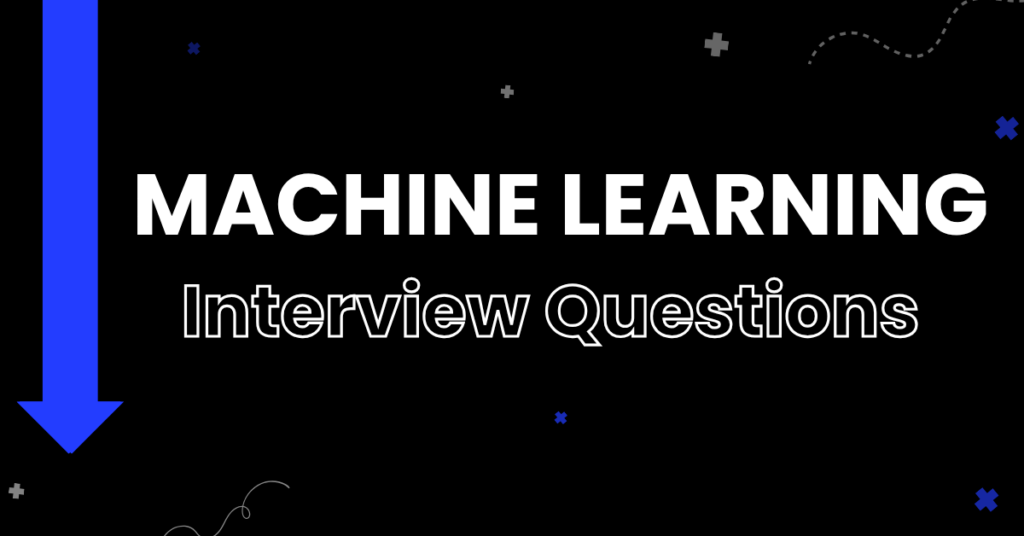Top 25 Machine Learning Interview Questions and Answers
Prepare smartly for your next data science or machine learning interview with the most commonly asked ML questions from basics to advanced.
Introduction:
Whether you’re a beginner or an experienced professional, cracking machine learning interviews requires clarity in both concepts and practical application. This guide covers the top ML interview questions most commonly asked by companies, ranging from supervised learning vs unsupervised, to model evaluation metrics, bias-variance tradeoff, and even real-world deployment challenges.
Let’s get started.
Machine Learning Interview Questions
1. What is the difference between supervised and unsupervised learning?
Answer:
- Supervised Learning uses labeled data. The algorithm learns to map inputs to outputs.
Example: Regression, Classification - Unsupervised Learning uses unlabeled data to identify hidden patterns.
Example: Clustering, Dimensionality Reduction.
2. Explain overfitting and underfitting. How can you prevent them?
Answer:
Overfitting happens when a model learns the training data too well, including noise and outliers. It performs excellently on training data but poorly on unseen data because it fails to generalize.
Prevention:
- Use cross-validation to test generalization
- Apply regularization (L1/L2) to reduce model complexity
- Prune decision trees
- Add more training data
- Use simpler models if needed
Underfitting occurs when a model is too simple to capture the underlying patterns in the data. It performs poorly on both training and test sets.
Prevention:
- Increase model complexity
- Improve feature engineering
- Train the model longer if necessary
- Reduce regularization
3. What is the bias-variance tradeoff?
Answer:
- Bias: Error due to simplistic assumptions in the model (underfitting).
- Variance: Error due to model complexity (overfitting).
- Tradeoff: Ideal model balances bias and variance to minimize total error.
4. How do personalized recommendation systems work in machine learning?
Answer:
Personalized recommendation systems suggest relevant content or products to users by analyzing their past behavior, preferences, and similarities with other users or items.
There are three main types:
- Collaborative Filtering: This approach recommends items based on the preferences of similar users. For example, Netflix suggests movies by identifying users with viewing habits similar to yours.
- Content-Based Filtering: This method recommends items similar to what the user has already liked or interacted with. For example, Spotify suggests songs based on the genres or artists you frequently listen to.
- Hybrid Approach: This combines collaborative and content-based filtering to provide more accurate and robust recommendations. Platforms like Amazon often use hybrid models for personalized shopping experiences.
5. What is the difference between classification and regression?
Answer:
Classification is used when the output variable is categorical, meaning it falls into discrete classes. The goal is to predict labels such as “spam” or “not spam.”
Examples include spam detection, disease diagnosis, and sentiment analysis. Common algorithms include Logistic Regression, Support Vector Machines (SVM), and Decision Tree Classifier.
Regression is used when the output variable is continuous, such as predicting a real-valued number. The goal is to estimate values like house prices or stock prices.
Examples include house price prediction, car emission forecasting, and stock market trends. Popular algorithms include Linear Regression, Random Forest Regressor, and XGBoost Regressor.
6. Explain the steps in a machine learning pipeline.
Answer:
- Data Collection
- Data Cleaning
- Exploratory Data Analysis (EDA)
- Feature Engineering
- Model Selection
- Training
- Evaluation
- Deployment & Monitoring
7. What is cross-validation? Why is it used?
Answer:
Cross-validation is a technique to assess model performance by splitting data into training and validation sets multiple times.
Use: Reduces overfitting, ensures generalization.
8. What are precision, recall, F1 score, and accuracy? When do you use each?
Answer:
1. Accuracy
- Use: When classes are balanced and all errors matter equally.
- Explanation: Measures how often the model is correct overall.
- Formula: (TP + TN) / (TP + TN + FP + FN)
- Precision
- Use: When false positives are more harmful (e.g., spam filter flagging real emails).
- Explanation: Of all predicted positives, how many are truly positive?
- Formula: TP / (TP + FP)
- Recall (Sensitivity)
- Use: When false negatives are more harmful (e.g., missing a cancer diagnosis).
- Explanation: Of all actual positives, how many did the model correctly find?
- Formula: TP / (TP + FN)
- F1 Score
- Use: When you need a balance between precision and recall (especially with imbalanced data).
- Explanation: Combines precision and recall into one metric using harmonic mean.
- Formula: 2 × (Precision × Recall) / (Precision + Recall)
9. What are the assumptions of a linear regression model?
Answer:
- Linearity: The relationship between the independent variables and the dependent variable should be linear.
- Independence: The residuals (errors) should be independent of each other—no autocorrelation.
- Homoscedasticity: The variance of residuals should remain constant across all levels of the independent variables.
- Normality: The residuals should follow a normal distribution, especially important for hypothesis testing.
- No Multicollinearity: The independent variables should not be highly correlated with one another, as it can distort coefficient estimates
10. How does a decision tree work? What are entropy and information gain?
Answer:
- A Decision Tree splits data into branches based on feature values to make decisions. At each step, the algorithm selects the best feature that divides the data to achieve maximum purity in child nodes. Decision Trees are intuitive, handle both categorical and numerical data, and are the building blocks for powerful ensembles like Random Forest and Gradient Boosted Trees.
- Entropy is a measure of impurity or randomness in the dataset. Lower entropy = pure node. Example: If all data points in a node belong to one class, entropy = 0.
- Information Gain is the reduction in entropy after a dataset is split on a feature.
- Formula: Information Gain = Entropy(Parent) – Weighted Avg. Entropy(Children)
- Higher information gain = better feature for splitting.
11. What is regularization? Explain L1 vs L2.
Answer:
- Regularization adds a penalty to the loss function to avoid overfitting.
- L1 (Lasso): Shrinks some coefficients to 0 (feature selection).
- L2 (Ridge): Shrinks all coefficients but doesn’t make them zero.
12. How does KNN work and how do you choose K?
Answer:
- K-Nearest Neighbors (KNN) classifies a data point based on the majority class among its K-nearest neighbors (for classification) or the average of neighbors (for regression)
- Choose K using cross-validation
- Small K = noise-sensitive; Large K = underfitting
13. What are the differences between bagging and boosting?
Answer:
- Bagging: Trains multiple models independently and averages predictions (e.g., Random Forest).
- Boosting: Trains models sequentially, each correcting the errors of the previous (e.g., XGBoost).
14. Explain how Random Forest works.
Answer:
- Ensemble of decision trees using bootstrapped samples and random feature selection.
- Reduce overfitting and improve accuracy.
15. What is PCA? How does it reduce dimensionality?
Answer:
- PCA (Principal Component Analysis) transforms data into fewer uncorrelated variables (principal components) that capture the most variance.
- Reduces dimensions while preserving information.
16. How do you handle imbalanced datasets?
Answer:
- Resampling: Over/Under Sampling
- Use metrics like ROC-AUC, F1
- Synthetic Data: SMOTE
- Algorithm-level solutions: Class weighting
17. What is the difference between ROC curve and Precision-Recall curve?
Answer:
- ROC Curve: Plots TPR vs FPR, good when classes are balanced.
- PR Curve: Plots precision vs recall, better for imbalanced data.
18. Explain the kernel trick in SVM.
Answer:
The kernel trick allows SVM to operate in a high-dimensional space without explicitly computing the transformation.
Common kernels: Linear, Polynomial, RBF
19. What are hyperparameters? How do you tune them?
Answer:
Hyperparameters are external settings of a model (e.g., learning rate, depth). They control how the model learns and performs.
Tuning methods:
- Grid Search
- Random Search
- Bayesian Optimization
- AutoML tools
20. Explain ensemble learning and different types of ensemble methods.
Answer:
Ensemble learning combines multiple models to improve performance.
Types:
- Bagging (Random Forest)
- Boosting (XGBoost, AdaBoost)
- Stacking (combining different algorithms)
21. What are some challenges in deploying ML models in production?
Answer:
- Data Drift
- Model Monitoring
- Version Control
- Scalability
- Latency
- Retraining pipelines
22. How do you handle data leakage in ML pipelines?
Answer:
- Ensure training data doesn’t include information from the test set.
- Avoid target leakage (e.g., using future data).
- Proper feature engineering within cross-validation.
23. What is the role of feature engineering in machine learning? Give examples.
Answer:
Feature engineering transforms raw data into useful features.
Examples:
- Encoding categorical variables
- Creating interaction features
- Binning, scaling, log transformation
24. How would you explain your ML model to a non-technical stakeholder?
Answer:
- Focus on business outcomes and impact
- Use simple analogies (e.g., decision tree = flowchart)
- Avoid jargon
- Show visuals (charts, confusion matrix)
25. What are the different types of clustering in machine learning?
Answer:
There are several types of clustering methods, each with its own approach:
- Partitioning Clustering: Divides the data into distinct, non-overlapping groups. Each data point belongs to exactly one cluster.
Example algorithms: K-Means, K-Medoids. - Hierarchical Clustering: Creates a hierarchy of clusters either using a bottom-up (agglomerative) or top-down (divisive) approach. The result is often visualized using a dendrogram.
Example algorithms: Agglomerative, Divisive Clustering. - Density-Based Clustering: Forms clusters based on areas of high data density, separated by low-density regions. It works well for arbitrarily shaped clusters and noise.
Example algorithms: DBSCAN, OPTICS.
Conclusion:
Cracking a machine learning interview is not just about knowing the right answers, it’s about understanding the core concepts and explaining them clearly. From model evaluation to algorithm selection, mastering these commonly asked questions can set you apart in any data science hiring process.
If you’re serious about building a career in Machine Learning or Data Science, it’s time to learn from the best.
At INTTRVU.AI, we offer a hands-on Data Science & AI Certification Program designed by industry experts. Whether you’re a fresher or working professional, our program covers everything from Python, Statistics, ML, GenAI, to real interview preparation with mock interviews.
Upskill. Get Interview-Ready. Land Top Offers. Join the next batch and level up your career with INTTRVU.AI!
Download the Machine Learning Interview PDF
FAQs on Machine Learning Interviews:
Most interviews ask about:
- Supervised vs Unsupervised Learning
- Overfitting and Underfitting
- Model Evaluation Metrics (Precision, Recall, F1, Accuracy)
- Bias-Variance Tradeoff
- ML Algorithms like Decision Trees, Random Forest, and SVM
Supervised learning uses labeled data to predict outcomes (e.g., classification, regression), while unsupervised learning identifies patterns in unlabeled data (e.g., clustering, dimensionality reduction).
- Precision: Use when false positives are costly (e.g., spam filters)
- Recall: Use when false negatives are risky (e.g., disease detection)
- F1 Score: Best for imbalanced data
- Accuracy: When classes are balanced
Overfitting means your model performs well on training data but poorly on test data.
Underfitting means your model is too simple and performs poorly on both.
Explain with examples and mention solutions like regularization, pruning, or more data.
- Blogs like INTTRVU.AI
- Hands-on practice on Kaggle
- YouTube tutorials on ML basics
- Mock interviews and coding platforms (e.g., LeetCode, InterviewBit)
- PDF guides and cheat sheets for quick revision



